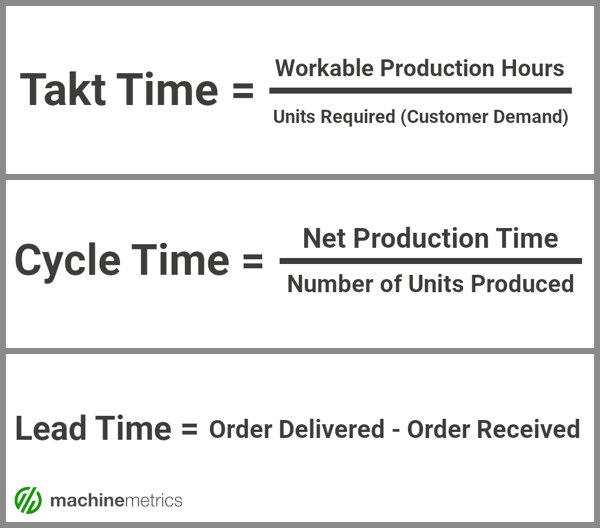Key Takeaways:
- Understanding the differences between takt time, cycle time, and lead time is crucial for optimizing manufacturing processes.
- Takt time aligns production with customer demand, cycle time measures the actual time taken for production, and lead time covers the total time from order to delivery.
- Balancing these metrics helps manufacturers enhance efficiency and meet customer expectations.
With IIoT, digital transformation, and the next industrial revolution underway, some resources make technology adoptions sound easy. Meanwhile, many are still confused about terms such as takt times, lead times, and cycle times. The following will explain the difference between these time metrics, the formulas behind them, how to calculate each, and how they can improve or hurt production.
Takt Time vs. Cycle Time vs. Lead Time
Lead time is essentially the total time it takes from the initial product order to the final delivery, whereas cycle time, a shorter period of time, is the average time it takes to complete a product. Lastly, takt time calculates the rate at which a manufacturer must complete a product to meet customer demand. We dive deeper into each of these time metrics below:

Takt Time
What is Takt Time?
Based on customer demand, takt time has nothing to do with how fast equipment operates or how fast workers are able to move. It is the blunt reality of how fast production must be to make deadlines. Takt time is the number of units in an order divided by the amount of workable production hours.
How to Calculate Takt Time
Tt = Pw / Ur
Where:
- Tt = Takt time
- Pw = Workable production hours
- Ur = Units required

When calculating workable hours do not include lunches, breaks, and other factors. Using technology able to document machine data in real-time may help determine or extrapolate workable hours. If the takt time and cycle time are in the same units (time/one unit), managers quickly see if a customer's needs could be met.
Additionally, managers with access to real-time technology platforms can see where bottlenecks are forming and react faster to production, inventory, and supply changes. Using technology to gain accurate lead times, cycle times, and takt times help maintain a smooth constant flow of production, highlight key performance indicators, and manage resources better.
Learn more about how to reduce your takt time.
Cycle Time
What is Cycle Time?
Another misunderstanding can come from using cycle time and process time interchangeably. Cycle time is sometimes used to describe how long it would take for equipment to complete a movement or process. Understanding how someone is using the word ‘cycle’ is important. The process time is the time a workpiece takes to enter and exit a workstation. Cycle time normally refers to the time it takes to work on a unit from start to finish. Some questions that might help communication are…
Are you tracking a process or unit?
Are you including wait or hold times?
There are other considerations, but if there is confusion around process or cycle time, these two questions will at least start a dialogue towards an understanding. Cycle time is calculated by the total production time divided by the units produced.
How to Calculate Cycle Time
Ct = Pt / Pu
Where:
- Ct = Cycle time
- Pt = Net production time
- Pu = Units produced during net production time

If a manager is able to find accurate repeatable cycle time and lead times, a takt time could determine how production relates to customer demand.
Learn more about how to reduce your cycle time.
Lead Time
What is Lead Time?
Confusion between these terms can be caused when people use them interchangeably. Perhaps the most misused term, lead time, can also be the easiest to find. Lead time is the time from when an order is received to when it is delivered to the customer.
How to Calculate Lead Time
Lt = Od - Or
Where:
- Lt = Lead time
- Od = When the order was delivered
- Or = When the order was received

For example, if an order was received on July 3rd, 2020, and delivered on August 20th, 2020 it would look like the following…
Lt = 8/20/2020 - 7/3/2020 = 1/17/0
Or 1 month, 17 days, 0 years
Converting everything to a common time such as days or seconds will make the math easier, but when presenting data make sure it is user-friendly. Presenting a lead time of millions of seconds might be effective for robots, but not people.
Learn more about how to reduce your lead time.
Understanding Manufacturing Time
A common mistake when considering if production is able to meet a customer’s demand is to only look at takt and cycle times. An order often can’t help a customer until it is received. While part of lead time; cycle times don’t include two things …
- The time between placing an order and starting production
- The time from the order's completion to delivery
These times should not be forgotten when calculating deadlines. Subtracting these times from the workable hours in the takt time formula might be an easy way to stay on schedule. Using takt, cycle, and lead times will require some level of consistency and repeatability. Including tool changes, maintenance, and a plan for unexpected downtime will improve accuracy in these times.
Find the best way to obtain and document accurate times. Involving workers in data collection can take away their time, focus, and motivation. Accurate or not, takt and cycle times that have workers walking around with stopwatches writing downtimes or timers constantly reminding them that another action or part should have been completed could cause fatigue both physically and emotionally. Maintaining skilled workers is important to maintaining or reducing cycle and lead times. Don’t lose, upset, or slow down valuable employees over stopwatches and forms. Instead leverage machine monitoring solutions that automatically track machine performance, including downtime and cycle time, and provide insight at multiple levels of the organization.
Reducing lead times and cycle times requires organization, control, and tracking. One way is to reduce unplanned downtime. A driver of IoT and connected products, predictive maintenance reduces equipment downtime which can greatly reduce process, cycle, and lead times. There are many technologies available, but first, find accurate times and machine data to determine where a solution would have the greatest impact to reduce cycle times and reduce lead times.
Using takt times with cycle and lead times should create informed managers that understand how to mitigate or add resources to hit needed production demands, not distract or add paperwork to a worker’s day. Lead times, cycle times, and takt times have simple formulas. However, the way these times are obtained and used will determine how well a company is able to control production to stay on the cutting edge.



.png?width=1960&height=1300&name=01_comp_Downtime-%26-Quality_laptop%20(1).png)





.gif)









Comments